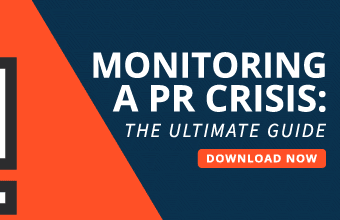We can’t predict the future, no matter how hard we try. Sometimes, events happen with absolutely no warning and shake companies to their very foundations. In times like these, it’s important to be ready for anything.
So how can you prepare yourself for anything that may come your way?
A crisis plan can get you there. Before we get into what needs to go into your crisis plan, let’s take a quick step back and cover what it is, as well as why you can benefit from having one.
What’s a crisis plan, and why do you need one?
In the briefest terms, a crisis plan is a detailed manual that sets out exactly what you’re going to do, as a company and on an individual level, in the event of something awful happening.
Crisis plans essentially allow you to employ strategic thinking for problems that haven’t come up yet. That way, you can prepare yourself well before anything actually happens, so that once something does happen, you know what your response is going to look like.
It’s important to know what you’re going to do and how you’re going to do it, so you’re not wasting time looking up questions like ‘how much is Docusign’ or, worse, ‘which esignature software do I need’ during a time of crisis when every minute counts.
Aside from helping you save precious seconds when they really count, crisis plans help you give clear instructions to employees no matter what. For example, if your crisis plan includes instructions for what to do in the event of a power outage at the office, you’ll be able to give directions to employees without needing to rely on the internet to communicate.
Component 1: Immediate response protocols
What’s the first thing you’ll do when a crisis begins?
You need to know exactly what your first steps are going to be, in as much detail as possible. It’s not enough to just say something like ‘we’ll have the CEO of the company sign an official statement’; you have to know what the statement will look like, and what kind of free esignature software you’ll have the CEO use for that signature.
That’s why the first crucial component of your crisis plan has to be a comprehensive breakdown of those important first steps.
Are you focusing on risk assessment, PR management, damage control, or something else? Who’s doing what? When does the initial response period end, and what comes after? These are the kinds of questions your crisis plan needs to answer.
Component 2: Liability plans
Of course, it’s never a good idea to point fingers and lay blame just for the sake of it. At the same time, when something unexpected does occur, you’ve got to know who’s liable for what, and what that means for you as a company.
You might, for example, want to know which department is responsible for which parts of your response. It can also be helpful to know whether a specific group within your company was associated with the things that are causing the crisis – not to blame them, but so you can figure out how to fix things.
You’ll also want to make sure that you’re not liable for any problems that might occur with companies or individuals your company works with. This ensures any crises your business faces aren’t the result of issues that are completely outside your company’s control.
To that end, making sure you and your business partners are making regular use of liability waivers can be a lifesaver. These waivers can also often find a place in your crisis plan.
Component 3: Crisis team
Just as you’ve got to know exactly what’s going to happen once the crisis begins, you need to be completely sure who’s in charge of which aspects of your response. In other words, you need to be clear on all the details of your crisis teams.
A crisis team might be made up of members of lots of regular teams—such as representatives from your PR, marketing, sales, and IT departments, for example. It might also be a team that always operates as one unit. Either way, the team members need to know who they’ll be working with, as well as what’s expected of them, in advance.
Your crisis team might, for example, be in charge of coordinating the crisis response as a whole. It might also be responsible for the initial response we discussed earlier.
Whatever the function you’d like to assign to your crisis team, you’ll want to set it out clearly in your crisis plan. It’s also important to review that function regularly to ensure it’s always a perfect fit for your needs.
So, in other words, your 2023 crisis plan may well look different from your 2024 one, and so forth.
Component 4: Media, PR, and outreach protocols
While there are many different kinds of crises, each with their own demands and requirements, most of them will call for some level of involvement from your PR and marketing teams.
PR teams are responsible for the outward appearance of the crisis you’re going through. If they’re in control of the situation, they can put a positive spin on just about anything—‘company in crisis’ becomes ‘company working towards better solutions’ with some clever PR work.
To that end, it’s vital to make sure your crisis plan has protocols in place for getting the PR teams all the information they need to stay on top of things.
Your company never wants to look like they’re surprised by what’s going on internally. For example, if a crisis involves a data breach, you don’t want to have company representatives acting surprised about the amount of data that was stolen or leaked. A well-informed PR team arms you against that sort of situation.
Your media team also has to know how much information to share with the public. Giving away too much can make your company look bad, while being excessively secretive makes it seem as though the situation is worse than it looks. Your media team helps you navigate that fine line.
Component 5: Internal communications procedures
Your employees also need to know what’s happening with regards to the crisis, including how they should respond to it and what your company’s official stance is.
The clearer you are in your internal communications, the more prepared your employees will be to respond appropriately to the crisis as it unfolds.
In light of the recent global pandemic, you’ve also got to make doubly sure your internal communications procedures account for just about every eventuality. You’ll want to expect the unexpected. No one would’ve imagined in 2019 that one year later, they’d mostly be working from home; your 2023 crisis plan needs to help you be ready for that kind of shift.
Internal communications need to work seamlessly at all times. Your crisis plan should lay out how that’s going to happen.
Also, your internal comms procedures should establish how much each employee needs to know in order to respond appropriately to any given crisis.
Component 6: Post-crisis reflection and review
No crisis plan is perfect from its first inception. You’ll want to leave room for your own crisis response protocols to grow and improve through post-crisis reflection.
Reflecting on and reviewing your crisis plan regularly gives you the opportunity to transform your crisis preparation over time. That means you’ll be ready to respond to new situations in 2023 and beyond.
To show the importance of regular reviews, let’s consider the example of the pandemic again. Before it broke out, few crisis plans would have had the right kinds of protocols in place to prepare for that sort of situation, simply because it was so unprecedented.
If a company did not take the chance to review its policies in the post-pandemic world, that company would leave itself vulnerable to more chaos in the event of another pandemic. It would also miss the opportunity to change its protocols for the better, which means missing out on growth.
And remember…
You may not always see a crisis coming before it happens, but that doesn’t have to be a bad thing. As long as you’re well-prepared, your company can weather any storm and come out of it just fine.
Your crisis plan is more than a contingency plan – it’s a roadmap, a fallback option, and a safety net all in one. You’ve got to treat it accordingly.
Make sure you include all vital components. Also, make sure you check your crisis plan regularly to make sure it still prepares you properly for any crisis you may face. That’s the best way to guarantee your business can navigate even the most dangerous waters safely.











